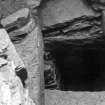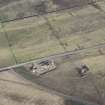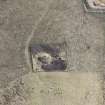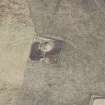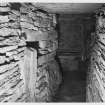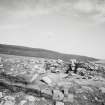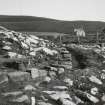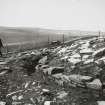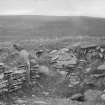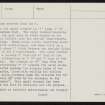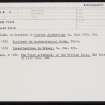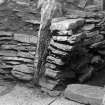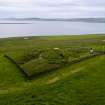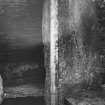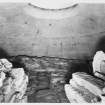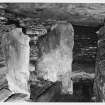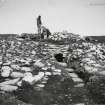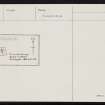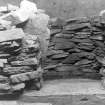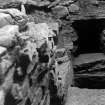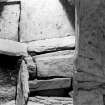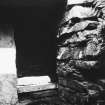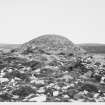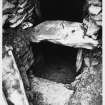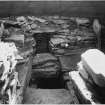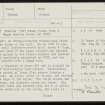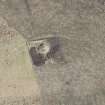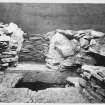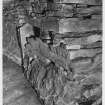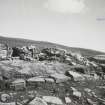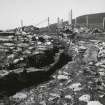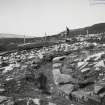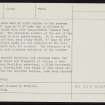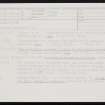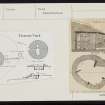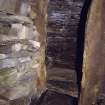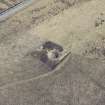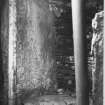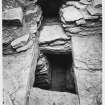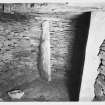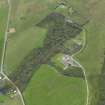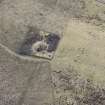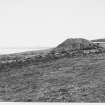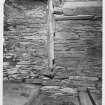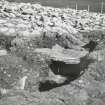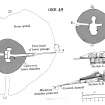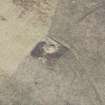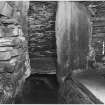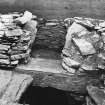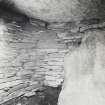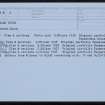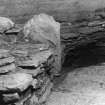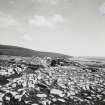Rousay, Taversoe Tuick
Chambered Cairn (Neolithic), Cist(S) (Neolithic), Cremation(S) (Neolithic), Inhumation(S) (Neolithic), Arrowhead (Flint)(Neolithic), Bead(S) (Shale)(Neolithic), Bowl(S) (Pottery)(Neolithic), Mace (Stone)(Neolithic)
Site Name Rousay, Taversoe Tuick
Classification Chambered Cairn (Neolithic), Cist(S) (Neolithic), Cremation(S) (Neolithic), Inhumation(S) (Neolithic), Arrowhead (Flint)(Neolithic), Bead(S) (Shale)(Neolithic), Bowl(S) (Pottery)(Neolithic), Mace (Stone)(Neolithic)
Canmore ID 2634
Site Number HY42NW 2
NGR HY 42585 27610
Datum OSGB36 - NGR
Permalink http://canmore.org.uk/site/2634
- Council Orkney Islands
- Parish Rousay And Egilsay
- Former Region Orkney Islands Area
- Former District Orkney
- Former County Orkney
HY42NW 2 4257 2761.
(HY 4257 2761) Tumulus (NR) Stone Cists, Urns & Human Remains found (AD 1899)
OS 6"map, Orkney, 2nd ed.,(1900).
"Taversoe Tuick", an Orkney-Cromarty Bookan-type cairn, situated on the slope of the hill. Up to 1898 it appeared to be a small heather-covered knoll about 4' high, but in that year part of the upper chamber was exposed and access was gained to the intact chamber and passage below. It was completely excavated in 1937, and the upper chamber covered with a domed roof.
The cairn has a diameter of about 30' and is bounded by a wall-face of horizontally laid stones. Surrounding the cairn is a spread of loose flat stones forming a sort of platform. An alley, clear of stones, led through it up to the W edge of the cairn. The cairn covers two separate chambers, one directly above the other. The upper, at ground level and entered from the N or uphill side, is placed centrally in the cairn; the lower is subterranean and entered from the S.
The passage to the upper chamber is 11' long, 1' 9" wide and 3' maximum high. The upper chamber measures 15' 6" by 6', its main axis at right angles to the passage. It is divided into two unequal compartments with rounded ends. Three stone cists, measuring about 1' 6" by 2', with cover-stones, had been built on a layer of earth about 1' thick between two upright slabs in the N wall of the W compartment. The lower chamber is entered by a passage 2' wide and 4' high at its inner end but contracting to 1' 5" and 2' high at the outermost lintel. The passage is 19' long from the chamber thus continuing 5' 6" outside the cairn above. Outside the roofed passage the sloping sides of the trench are visible, lined with walling but without lintels. The walls continue down the hillside for 19' narrowing to only 2 1/2" wide by the entrance to the "miniature chamber". This small channel has been called a drain but this is obviously not its purpose.
The lower chamber is entirely subterranean and roughly oval with the main axis at right angles to the passage. It measures 12' long by 5' 4" wide and is divided by five vertical slabs into four compartments opening from a central space. The miniature chamber at the end of the passage extension is also subterranean. It is roughly oval in plan, the main axis lying SW-NE, 5' long by 4'4" wide. Four upright slabs are set radially in the wall and hardly project into the chamber. The entrance is by a vertical drop into a narrow extension of the chamber on the SW. Finds include several skeletons and cremated bone, two complete Unstan bowls and fragments of others, a perforated secondary Neolithic mace-head, a flint arrowhead, flint scrapers, thirty-five disc beads of grey shale etc, which, except for the skeleton remains, have been donated to the National Museum of Antiquities of Scotland.
A S Henshall 1963; RCAHMS 1946; W G Grant 1939; J Phemister 1942.
As described and planned by Henshall.
Surveyed at 1/2500.
Visited by OS(ISS) 8 October 1972.
'The Orkney Herald' in 1898 describes the excavation of the site, from May 5th 1898.
M Howe 2006
Excavation (1898)
"Taversoe Tuick", an Orkney-Cromarty Bookan-type cairn, situated on the slope of the hill. Up to 1898 it appeared to be a small heather-covered knoll about 4' high, but in that year part of the upper chamber was exposed and access was gained to the intact chamber and passage below.
Field Visit (1941)
Visited by Childe in 1941.
V G Childe 1942
Note (1982)
Taversoe Tuick (ORK 49) HY 4257 2761 HY42NW 2
This unusual tomb, in SOD guardianship, comprises two chambers one set immediately above the other, with a smaller rock-cut chamber a little to the SE. The lower chamber, entered from the SE, is divided into four compartments by upright slabs; the upper chamber, entered from the N, is divided into two unequal compartments. It is the only example of the Bookan class of tomb on Rousay. Finds in NMAS.
RCAHMS 1982
(MS account of discovery by Lady Burroughs (under pseudonym Veronica) in Orkney Archives, copies in NMRS; Wilson Portfolio ff. 13-15; Turner 1903; Grant 1939a; Phemister and Scott 1942, 131-2; RCAHMS 1946, ii, pp. 206-9, No. 570; Henshall 1963, 234-8; OR 594)
Publication Account (1996)
This is one of two Orcadian tombs remarkable for their double-storey design; the other is Huntersquoy on Eday (HY 562377) of which little can now be seen. In both cases, there is an upper and a lower chamber, each with its own entrancepassage opening 111 diametrically opposed directions and with no access between the two, so that they are in effect two separate tombs although they appear to have been built simultaneously. At Taversoe Tuick it is possible to enter both chambers, and to look into an unusual miniature 'tomb' built at the edge of the platform on which the main tomb stands, close close to the passage leading into the lower chamber. It 'contained three pottery bowls and may have been connected with ritual activities.
Information from ‘Exploring Scotland’s Heritage: Orkney’, (1996).
Orkney Smr Note (December 1997)
In the early 1990's on the 18th Dec, mid morning. I observed the sun shining along the passage leading to the lower chamber.
Information from Orkney SMR (JG) 18 December 97
Note (2020)
Taversoe Tuick
This burial site in Orkney Islands was a focus for funerary practices in the Neolithic period, between 4000 BC and 3351 BC.
Prehistoric Grave Goods project site ID: 60077
CANMORE ID: 2634
Total no. graves with grave goods: 6
Total no. people with grave goods: 10
Total no. grave goods: 11
Prehistoric Grave Goods project Grave ID: 74060
Grave type: Chamber
Burial type(s): Inhumation, Inhumation, Inhumation
Grave good: Pot; Materials used: Pottery; Current museum location: National Museum of Scotland
Grave good: Pot; Materials used: Pottery; Current museum location: National Museum of Scotland
Grave good: Knife; Materials used: Chert / Flint [Flint]; Current museum location: National Museum of Scotland; Museum accession no.: X.EO 749
Prehistoric Grave Goods project Grave ID: 74061
Grave type: Passage
Burial type(s): Cremation, Cremation, Cremation
Grave good: Macehead; Materials used: Granite; Current museum location: National Museum of Scotland; Museum accession no.: X.EO 378
Grave good: Arrowhead; Materials used: Chert / Flint [Flint]; Current museum location: National Museum of Scotland; Museum accession no.: X.EO 748
Grave good: Pot; Materials used: Pottery; Current museum location: National Museum of Scotland
Grave good: Pot; Materials used: Pottery; Current museum location: National Museum of Scotland
Prehistoric Grave Goods project Grave ID: 74062
Grave type: Cist
Burial type(s): Cremation
Grave good: Pot (Unknown/Unspecified); Materials used: Pottery; Current museum location: National Museum of Scotland
Prehistoric Grave Goods project Grave ID: 74063
Grave type: Chamber
Burial type(s): Inhumation
Grave good: Pot; Materials used: Pottery; Current museum location: National Museum of Scotland
Prehistoric Grave Goods project Grave ID: 74065
Grave type: Cist
Burial type(s): Cremation
Grave good: Pot (Unknown/Unspecified); Materials used: Pottery; Current museum location: National Museum of Scotland
Prehistoric Grave Goods project Grave ID: 74066
Grave type: Cist
Burial type(s): Cremation
Grave good: Pot; Materials used: Pottery; Current museum location: National Museum of Scotland
Further details, the full project database and downloads of project publications can be found here: https://doi.org/10.5284/1052206
An accessible visualisation of the database can be found here: http://blogs.reading.ac.uk/grave-goods/map/


































































